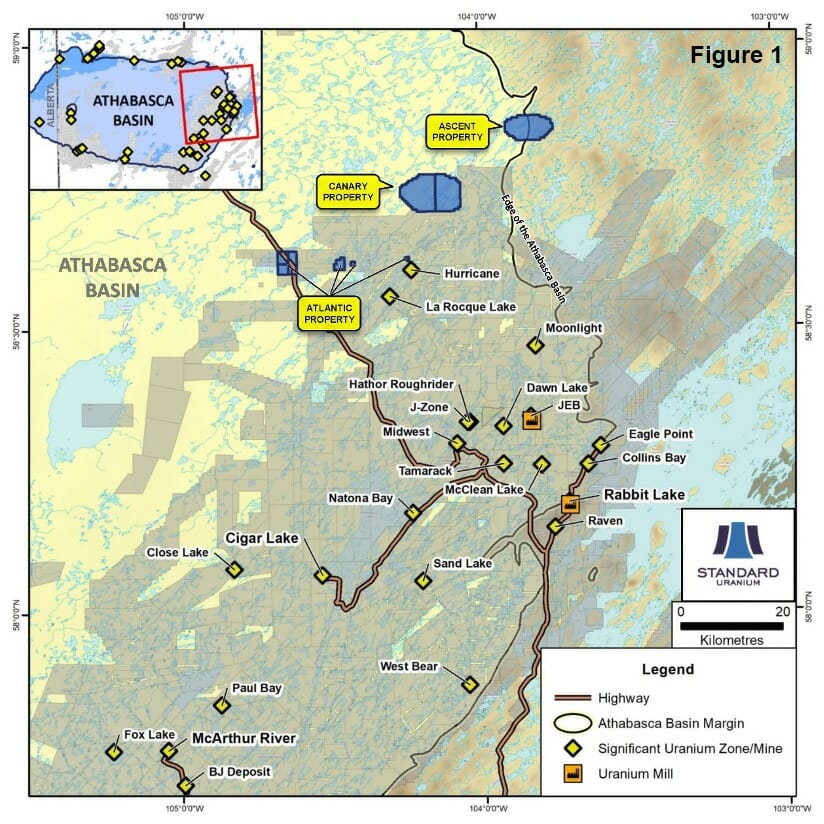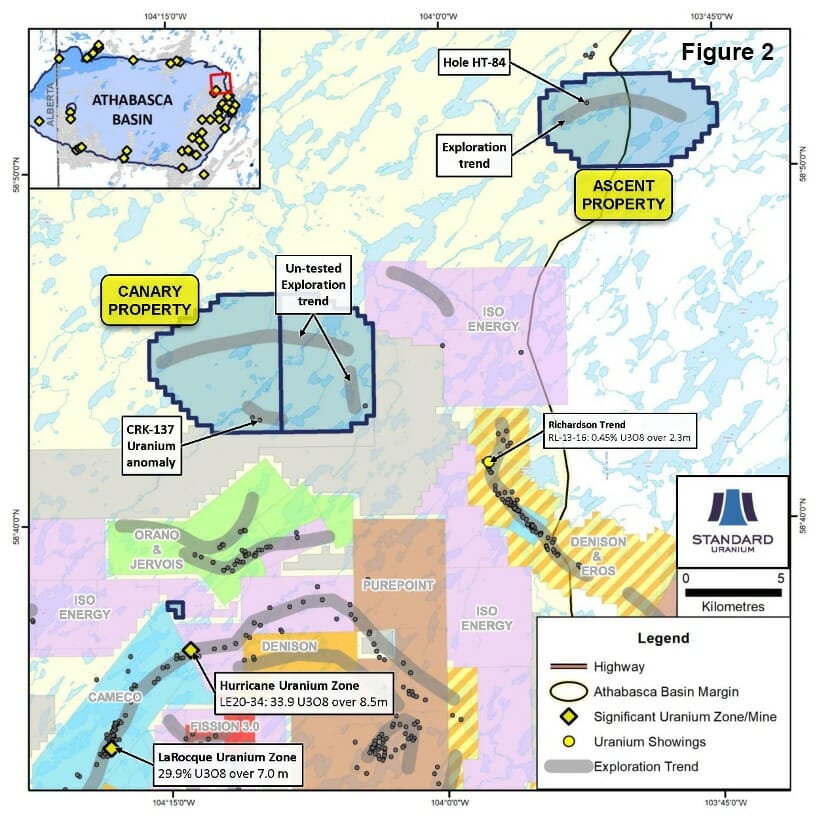VANCOUVER, British Columbia, July 9, 2020 — Standard Uranium Ltd. (“Standard Uranium” or the “Company”) (TSX-V: STND) is pleased to announce that it has acquired, through staking, two new projects in the eastern Athabasca Basin, totalling 11,040 Hectares. The Canary and Ascent Projects are located 40 kilometers north east of the Company’s Atlantic project (see Figure 1) and approximately 12 and 33 kilometres, respectively, from IsoEnergy’s Hurricane Zone at their Larocque East Project (See Figure 2).

Figure 1: Standard Uranium Canary and Ascent Projects relative to Atlantic Property.
Canary Project Highlights
- Two claims totalling 7,303 Ha.
- Depth to the sub-Athabasca unconformity is known to be between 84 and 230 metres from the surface.
- Historical airborne EM work between 1993 and 2006 has identified three (3) conductive corridors that identify as graphitic meta-sediments, which are prospective host rocks for uranium mineralization.
- Historical ground EM and IP surveys have confirmed two prospective target areas on the property related to structural disruptions of the conductive corridors.
- Historical drill-hole CRK-137 identified highly anomalous uranium enrichment near the unconformity with 10 ppm uranium over 7.4 metres in systematic composite sampling of the sandstone, and strong hydrothermal alteration was observed throughout the interval. Within this zone, a discrete 0.5m sub-interval returned 103.1 ppm uranium; and a 1.0m interval in the graphitic meta-sediments immediately below the unconformity returned 200.0 ppm uranium.
- Only one of the three conductive targets have been tested by drilling, and the one that has been tested is considered highly anomalous.
Ascent Project Highlights
- One claim totalling 3,737 Ha.
- Depth to the sub-Athabasca unconformity is known to be between 0 and about 50 metres from the surface. The eastern part of the project has no Athabasca sandstone cover.
- Historical airborne EM work in 1979 and 2006 has identified one large, 6-km long and 3-km wide conductive corridor with numerous target areas related to potential cross structures.
- In the early 1980’s the area was covered with ground EM surveys and confirmed the airborne targets.
- A 1979 lake sediment sampling program identified a very high-priority Radon-U-Co-Ni-Zn-Mo-Pb-V anomaly located immediately above the conductive target.
- Regional prospecting by historical operators identified uranium enrichment in basement rocks located east of the Athabasca Basin edge and support the exploration model for uranium on the property.
- Only one drill-hole has tested the extensive conductive corridor in 1984, with 6 kilometres of strike length remaining un-tested.
- The current exploration model for this project is analogous to that of the J-Zone and Roughrider deposits, that are located next to a similar looking airborne EM target that has dimensions of roughly 2-km long by 1-km wide. Both targets at the Ascent project and the J-Zone and Roughrider deposits are interpreted by the company to be shallow-dipping conductive bodies, and therefore did not fit the historical exploration model of a good conductor to focus on.

Figure 2: Standard Uranium Canary and Ascent Projects relative to IsoEnergy’s Larocque East Project
These two new projects bolster our presence in the Eastern Athabasca Region, and compliment the Company’s existing Atlantic Project. The projects can potentially be explored at the same time in order to see cost savings in future exploration campaigns. The Eastern Athabasca Basin region has been the hub of uranium exploration and mining for the past 50 years, and the region is highlighted by three licensed uranium mills. Even though the region has been the mainstay of uranium exploration, several important uranium discoveries have been made in the last 12 years including Roughrider, J-Zone, Phoenix, Gryphon and Fox Lake. The northern portion of the Eastern Athabasca Basin where the Company’s Canary, Ascent and Atlantic projects are situated has seen relatively less drilling than the rest of the region. The Company has defined this as an excellent chance to add value and increase the chances for a new discovery in areas that have fundamentally strong geology and have positive historical exploration results.
Atlantic Project Highlights
- Six claims totalling 2,176 Ha.
- Covers 6.5 kilometres of an 18 km long, east-west trending conductive exploration trend, located due west of IsoEnergy’s Hurricane Zone.
- Depth to the sub-Athabasca unconformity is known to be between 230 and 485 metres from the surface.
- Historical Drilling by Cameco in 1992 (hole BE-04) encountered up to 586 pm uranium over 0.5 metres in the sandstone, near the unconformity. Additionally, the hole encountered elevated uranium, nickel, illite and chlorite in the lower 10 metres of sandstone.
- Follow-up drilling by Denison Mines in 2012 (Hole BL12-13), next to BE-04, encountered a fault-zone located 130 metres above the sandstone that contains 10.2 ppm uranium, 786 ppm lead and 2,270 ppm zinc and other base-metals over 0.1 metres. Additionally, a composite sample of the basal 13.4 metres of sandstone returned 477 ppm uranium.
- At the western claim block, drilling by Denison Mines in 2016 (Hole BL16-32) encountered 342 ppm uranium over 0.5 metres at the base of the sandstone.
Neil McCallum, VP Exploration, states: ”We are committed to success at our flagship Davidson River Property in the southwest Athabasca region where our maiden drill program will commence within the month given that the COVID-19 situation remains stable. In the meantime, we have been actively reviewing new projects that contain technically strong exploration targets with discovery potential to round out our portfolio in a proven uranium exploration and mining region with relatively shallow target depths.”
About Standard Uranium (TSX-V: STND)
We find the fuel to power a clean energy future
Standard Uranium is a mineral resource exploration company based in Vancouver, British Columbia. Since its establishment, Standard Uranium has focused on the identification and development of prospective exploration stage uranium projects in the Athabasca Basin in Saskatchewan, Canada. Standard Uranium’s Davidson River Project, in the southwest part of the Athabasca Basin, Saskatchewan, is comprised of 21 mineral claims over 25,886 hectares. The Davidson River Project is highly prospective for basement hosted uranium deposits yet remains untested by drilling despite its location along trend from recent high-grade uranium discoveries. A copy of the 43-101 Technical Report that summarizes the exploration on the project is available for review under Standard Uranium’s SEDAR issuer profile (www.sedar.com). For more information visit: www.standarduranium.ca.
For further information contact:
Jon Bey, President, Chief Executive Officer, and Chairman
550 Denman Street, Suite 200
Vancouver, BC V6G 3H1
Tel: 1 (604) 375-4488
E-mail: info@standarduranium.ca
Cautionary Statement Regarding Forward-Looking Statements
This news release includes certain information and statements about management’s view of future events, expectations, plans and prospects that constitute “forward looking statements”, which are not composed of historical facts. Forward-looking statements may be identified by such terms as “believes”, “anticipates”, “intends”, “expects”, “estimates”, “may”, “could”, “would”, “will”, or “plan”, and similar expressions. Specifically, forward looking statements in this news release include, without limitation, statements regarding: the closing of the Offering and the use of proceeds therefrom; the timing and content of upcoming work programs, geological interpretations, receipt of property titles, potential mineral recovery processes, and estimates of market conditions. These statements involve known and unknown risks, uncertainties, and other factors that may cause actual results or events, performance, or achievements of the Company to differ materially from those anticipated or implied in such forward-looking statements. The Company believes that the expectations reflected in these forward-looking statements are reasonable, but there can be no assurance that actual results will meet management’s expectations. In formulating the forward-looking statements contained herein, management has assumed that business and economic conditions affecting the Company will continue substantially in the ordinary course and will be favourable to the Company. Factors that may cause actual results to differ materially from those anticipated by these forward looking statements include: the need to satisfy regulatory and legal requirements with respect to the Offering; the ability to complete the financing on the terms as announced or at all; changes in equity markets; the Company’s ability to raise additional capital if and when necessary; and other factors as described in detail in the Company’s Preliminary Prospectus other public filings, all of which may be viewed on SEDAR (www.sedar.com). Given these risks and uncertainties, readers are cautioned not to place undue reliance on such forward looking statements and information, which are qualified in their entirety by this cautionary statement. Except as required by law, the Company disclaims any intention and assumes no obligation to update or revise any forward looking statements to reflect actual results, whether as a result of new information, future events, changes in assumptions, changes in factors affecting such forward looking statements or otherwise.
Neither TSX-V nor its Regulation Services Provider (as that term is defined in the policies of the TSX-V) accepts responsibility for the adequacy or accuracy of this release.
